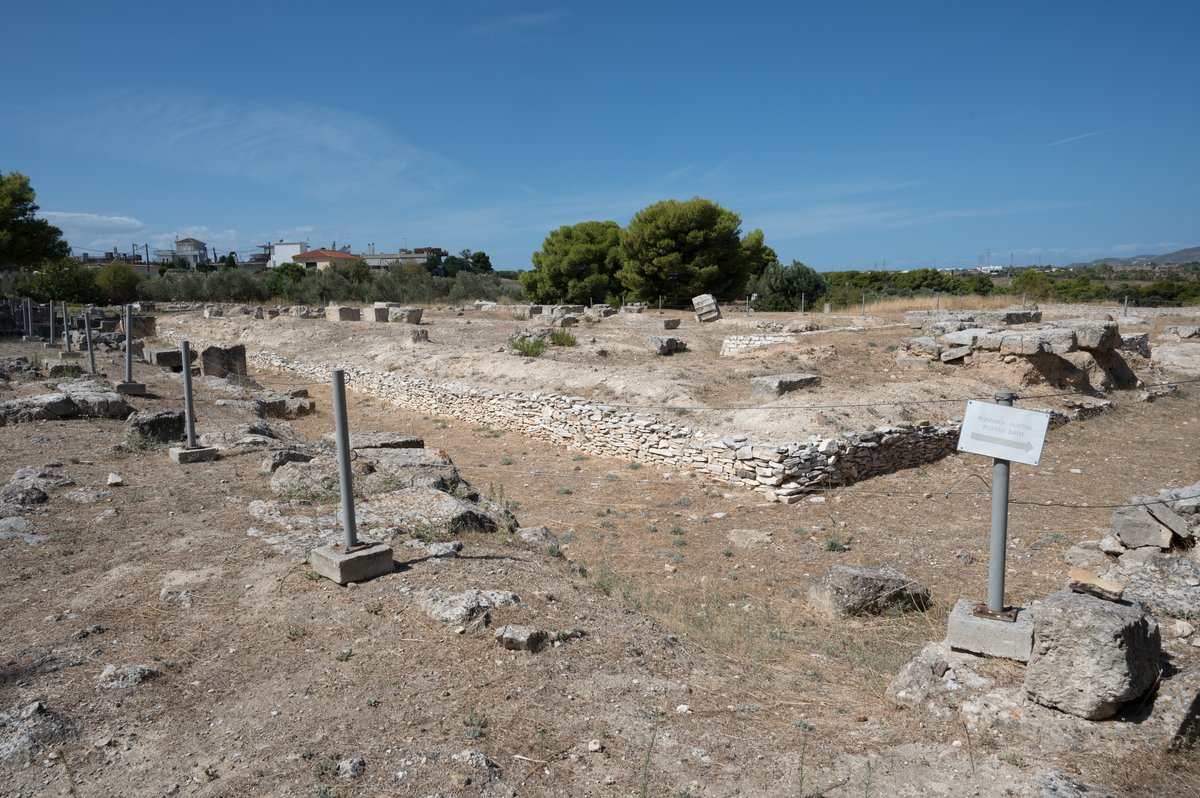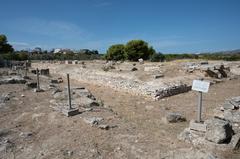
Poseidon Temple of Isthmia: Visiting Hours, Tickets, and Historical Significance in Loutraki, Greece
Date: 14/06/2025
Introduction
The Sanctuary of Poseidon at Isthmia, located near Loutraki on the Isthmus of Corinth, is a cornerstone of ancient Greek religious and athletic tradition. Revered as the venue for the prestigious Isthmian Games—one of the four great Panhellenic festivals—this site reflects the enduring influence of Poseidon, god of the sea, horses, and earthquakes. Its strategic location at the crossroads of major land and sea routes endowed Isthmia with religious, political, and economic significance for over a millennium.
Today, the archaeological site and its adjacent museum provide a comprehensive journey through history, from its Archaic origins in the 7th century BCE to its Roman transformations and eventual decline. Visitors can explore temple ruins, athletic facilities, Roman baths, and impressive fortifications, all set amidst a scenic landscape. The nearby town of Loutraki offers modern amenities, making Isthmia an ideal destination for travelers interested in Greek heritage.
This guide details everything you need to know: visiting hours, tickets, accessibility, travel tips, and the historical context that enriches your visit. For the latest updates, consult the official Hellenic Ministry of Culture, Visit Loutraki, and the Rockpile Project.
Table of Contents
- Introduction
- Visiting Hours and Tickets
- Accessibility and Visitor Amenities
- How to Get There
- Nearby Attractions
- Historical Overview and Significance
- Architectural Evolution and Layout
- Notable Architectural Features
- Visitor Information
- Travel Tips
- Archaeological Discoveries and Insights
- Visiting the Isthmian Games Site
- Location and Access
- Site Layout and Main Attractions
- The Archaeological Museum of Isthmia
- Visitor Experience and Practical Tips
- Cultural and Historical Context
- Frequently Asked Questions (FAQ)
- Recommendations and Final Tips
- Call to Action
- References
Visiting Hours and Tickets
The Sanctuary of Poseidon at Isthmia is open throughout the year. Standard visiting hours are:
Please verify current hours on the Hellenic Ministry of Culture website, as they can vary due to holidays or special events.
Tickets:
- Adults: ~€8
- Reduced rates for students, seniors, and children
- Free entry for children under 18 and other qualifying groups
- Combined tickets may be available for multiple sites in the region
Tickets can be bought on-site or online via official platforms for greater convenience.
Accessibility and Visitor Amenities
- Mobility: Main paths and museum areas are wheelchair accessible, though some ancient terrain is uneven.
- Signage: Informational panels in multiple languages enhance the visitor experience.
- Amenities: Rest areas, parking, restrooms, a café, and a gift shop are available.
- Guided Tours: Offered in multiple languages; advance booking recommended, especially for groups or special interests.
- Wi-Fi: Available in main areas.
How to Get There
- By Car: Located about 7 km east of Loutraki and 16 km from ancient Corinth. Accessible via major highways from Athens, Loutraki, Patras, and Epidaurus.
- By Bus: Intercity buses from Athens stop at Corinth; from there, taxis or shuttles reach Isthmia.
- By Train: Suburban trains from Athens/Piraeus to N. Korinthos Station; taxis cover the final 6 km.
- Nearby Facilities: Loutraki and Isthmia offer hotels, campsites, tavernas, and cafes.
(rockpileproject.com, visitloutraki.com)
Nearby Attractions
- Corinth Canal: An engineering marvel offering cruises and bungee jumping.
- Ancient Corinth: Archaeological site and museum, plus the Acrocorinth fortress.
- Loutraki: Renowned for its thermal spa, beaches, and vibrant promenade.
- Akrocorinthos: The acropolis of ancient Corinth with panoramic views.
Historical Overview and Significance
Origins and Early History
The sanctuary’s origins date to the late Geometric period (circa 900–700 BCE), with the first major temple built in the early 7th century BCE. It was dedicated to Poseidon, reflecting the maritime and equestrian culture vital to the region. Its position at the Isthmus made it a focal point for trade, travel, and military passage.
(greek.mythologyworldwide.com)
Architectural Development
The original wooden peristyle temple was replaced in the mid-6th century BCE by a monumental Doric structure. Key features included a limestone colonnade, expansive altar, and a precinct with treasuries and stoas.
The Isthmian Games
Held biennially from 582/581 BCE, the Isthmian Games were second only to the Olympics in prestige. Events included footraces, wrestling, boxing, pankration, chariot and horse races, and, later, musical and poetic contests. The Games fostered unity among city-states, serving as neutral ground for diplomacy and cultural exchange.
(Travel the Greek Way, Wikipedia)
Cult and Ritual Practices
Worship involved sacrifices (bulls, rams, horses), offerings, libations, and oracular consultations. Shrines to Palaemon, Demeter, and others reflected a diverse religious landscape, while votive offerings ranged from simple vessels to luxury items, indicating broad participation.
Political and Strategic Importance
The sanctuary’s location made it a political asset, contested by Corinth and Athens. Its neutrality during the Games allowed safe passage even in wartime. Notably, it hosted the assembly that formed the Hellenic League against Persia in 481 BCE.
Artistic and Cultural Legacy
Sculptures, pottery, and inscriptions depict Poseidon and mythic scenes. The sanctuary influenced literature—mentioned by Pindar and Pausanias—and continues to inspire modern scholarship.
Decline and Rediscovery
Following Corinth’s destruction in 146 BCE, the sanctuary declined but persisted through the Roman period. The final Games were held in the late 4th century CE before Christianization led to abandonment. Modern excavations began in the 20th century, expanding our understanding of the site.
Architectural Evolution and Layout
Early Foundations and Archaic Temple
- Founded ca. 690–650 BCE (warwick.ac.uk)
- Archaic temple featured a wooden Doric peristyle and central row of columns, setting precedents for later stone temples (msuisthmia.org)
Destruction and Classical Reconstruction
- Destroyed by fire circa 480 BCE; rebuilt by 465 BCE with a stone peristyle, enlarged dimensions, and improved altar precinct (visitpeloponnese.com)
Hellenistic and Roman Modifications
- Stadium and theatre expanded; hysplex starting gates introduced.
- Roman rebuilding after 44 BCE included the Temple of Palaemon and bathhouses with intricate mosaics (msuisthmia.org)
Late Antiquity and the Hexamilion Wall
- By the late 4th century CE, the site was abandoned. The Hexamilion Wall, built for defense using temple stones, marks this final phase (msuisthmia.org)
Notable Architectural Features
- Doric order: Sturdy columns, simple capitals, and an innovative ground plan.
- Stadium and Theatre: Venues for athletic and musical events.
- Roman bathhouses: Mosaic floors depicting marine motifs.
- Hexamilion Wall: The largest ancient structure in Greece, built for defense.
Visitor Information
Opening Hours
- Summer: 8:00 AM – 7:00 PM
- Winter: 8:00 AM – 5:00 PM
- Closed on select holidays
Tickets and Admission
- Adults: ~€8
- Discounts for students, seniors, EU citizens
- Free for children under 18
- Purchase on-site or online
Accessibility
- Main paths and museum are wheelchair accessible.
- Some ancient terrain is uneven; assistance available upon request.
Guided Tours and Events
- Bookable in advance, available in several languages.
- Special events and lectures held during the summer.
Facilities
- Visitor center, restrooms, café, gift shop, free Wi-Fi.
Travel Tips
- Wear comfortable, sturdy shoes.
- Bring sun protection and water.
- Allocate at least 2–3 hours for a thorough visit.
- Combine with other regional sites for a full day of exploration.
Archaeological Discoveries and Insights
Major excavations began in the 1950s with Oscar Broneer and continue through the American School of Classical Studies and Ohio State University. Highlights include coins, sculptures (such as “The Two Cybeles”), architectural fragments, and exquisite Roman mosaics.
(warwick.ac.uk, visitpeloponnese.com, msuisthmia.org)
Visiting the Isthmian Games Site
The Isthmian Games, established in 582/581 BCE, were held every two years at the Sanctuary of Poseidon. They included athletic competitions, sacrifices, and artistic performances, serving both religious and diplomatic functions. Under Roman rule, new events and buildings were added, including elaborate baths and the Temple of Palaemon. The Games ended in the late 4th century CE with the rise of Christianity, but their legacy endures.
(Wikipedia, Travel the Greek Way)
Location and Access
The site lies 16 km east of ancient Corinth and about 77 km from Athens, easily accessible by car, bus, or train. The modern villages of Isthmia and Loutraki provide accommodation and dining options, making it convenient for both day trips and longer stays.
(visitloutraki.com, rockpileproject.com)
Site Layout and Main Attractions
Temple of Poseidon
- Originally built in the 7th century BCE, rebuilt after fire in 440 BCE.
- Early example of monumental Doric architecture, featuring wooden and later stone columns, a grand altar, terracotta roof tiles, painted friezes, and a marble basin supported by Korai statues.
(wikipedia.org, madainproject.com, jvwanderings.com)
Stadium
- 6th-century BCE structure, expanded in the Hellenistic period, with visible starting blocks and lanes.
- Venue for the Isthmian Games.
(ermioni.info, rockpileproject.com)
Theatre
- Built around 400 BCE, renovated in later centuries, reflecting the integration of cultural performances into festival life.
Roman Baths and Pools
- 2nd-century CE baths feature mosaic floors and a 30-meter-long pool, showcasing Roman engineering and leisure culture.
Palaimonion and Cult Caves
- Monument to Palaemon, mythic hero of the Games, and shrines to other deities.
(rockpileproject.com, ermioni.info)
Hexamilion Wall
- 7.7 km-long fortification from the early 5th century CE, built using stones from the sanctuary.
(rockpileproject.com, ermioni.info)
The Archaeological Museum of Isthmia
Opened in 1978, the museum displays artifacts from the sanctuary and nearby port of Kenchreai. Highlights include the marble basin, bronze helmet, statues, and mosaic panels. The accessible, open-plan hall provides a chronological overview from the Mycenaean to Roman periods.
(madainproject.com, ermioni.info)
Visitor Experience and Practical Tips
- Start at the museum for context before exploring the site.
- Wear suitable footwear for uneven ground.
- Bring sun protection and water, especially in summer.
- Guided tours enhance understanding of the site’s significance.
- Local amenities in Isthmia and Loutraki include hotels, restaurants, and cafes.
Cultural and Historical Context
Isthmia was one of four great Panhellenic sanctuaries—alongside Olympia, Delphi, and Nemea. The Games attracted figures such as Alexander the Great, Emperor Nero, and the Apostle Paul. Its history mirrors the evolution of Greek civilization, from the rise of monumental architecture and athletic competition to Roman transformation and Christian decline.
(wikipedia.org, ermioni.info, madainproject.com)
Frequently Asked Questions (FAQ)
What are the visiting hours?
Generally 8:00 AM – 7:00 PM in summer, 8:00 AM – 4:30 or 5:00 PM in winter. Check official sources for updates.
How much is admission?
Adults ~€8; discounts for students, seniors, and groups; free for children under 18.
Is the site accessible?
Main paths and museum are accessible; some terrain is uneven.
Are guided tours available?
Yes, in multiple languages, bookable in advance.
What else can I visit nearby?
Ancient Corinth, the Corinth Canal, Loutraki spa, and Akrocorinthos.
Recommendations and Final Tips
- Reserve half a day for both the site and museum.
- Pair your visit with other local sites for a diverse experience.
- Prepare for outdoor weather and uneven ground.
- Consider a guided tour for deeper insight.
- Check for local events or festivals to enhance your visit.
Call to Action
Plan your visit to the Poseidon Temple of Isthmia and experience one of Greece’s most significant historical sites. For the latest updates, ticket info, and travel tips, download the Audiala app and connect with us on social media. Explore related articles on our website and deepen your understanding of Greece’s vibrant heritage.
For further planning, consult Visit Loutraki, Rockpile Project, and the Isthmia Archaeological Museum.
References
- Visiting the Sanctuary of Poseidon at Isthmia: Hours, Tickets, and Historical Insights, 2025 (Hellenic Ministry of Culture)
- Visiting the Temple of Poseidon at Isthmia: Hours, Tickets, History & Travel Tips, 2025 (warwick.ac.uk)
- Visiting the Isthmian Games Site: History, Tickets, and Travel Tips, 2025 (Wikipedia)
- Poseidon Temple of Isthmia: Visiting Hours, Tickets, and Guide to Corinth’s Historical Site, 2025 (Visit Loutraki)
- Poseidon Temple of Isthmia, 2025 (Rockpile Project)
- Archaeological Museum of Isthmia, 2025 (ermioni.info)
